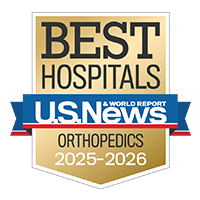Separated Shoulder

Overview
Separated shoulder, also known as acromioclavicular (AC) joint separation, is a sprain of the ligaments that attach the clavicle (collarbone) to the acromion (highest part of the scapula, or shoulder blade). The sprain can be either partial, with minimal separation of the clavicle and acromion, or complete, which means the bones have come entirely apart. Treatment depends on the amount of displacement seen on X-rays.
Separated shoulder commonly occurs from a direct blow to the lateral (outside) part of the shoulder or from falling on an outstretched hand or elbow. The injury is common in contact sports and from falls while biking, skiing or snowboarding.
Our approach to separated shoulder
For less severe injuries, a separated shoulder typically heals on its own, with simple treatments to reduce pain and swelling, such as using ice packs, pain medication and an arm sling. But for more severe separations, or in cases of prolonged pain, surgery may be appropriate to either repair or reconstruct the damaged ligaments.
If you need surgery, our team includes orthopedic surgeons who specialize in the shoulder; physical therapists who focus on orthopedic and sports-medicine patients; primary care sports medicine doctors; and athletic trainers, who educate patients in proper recovery methods. Our experts work together to relieve pain and restore mobility, so patients can return to their normal lives and the activities they enjoy.
Awards & recognition
-

Among the top hospitals in the nation
-

Best in Northern California and No. 6 in the nation for orthopedic care
Signs & symptoms
Tenderness and swelling at the top of the shoulder are common right after the injury; bruising in the area is usually seen about 48 hours later. With more severe injuries, the end of the collarbone may be prominent. Shortly after injury, most people find moving the arm and shoulder painful, as the entire area around the joint becomes inflamed.
Diagnosis
A separated shoulder can often be identified during a physical exam, but your doctor will likely use X-rays to gauge the severity. Other specialized tests, such as MRI or CT, may also help with diagnosis and detecting any associated injuries.
Treatments
Nonsurgical treatment
Initial treatment of a mild shoulder separation consists of taking pain medication and applying ice to relieve the immediate symptoms. A sling is often used for seven to 10 days to provide comfort while the joint begins to heal. X-rays are usually taken to assess the displacement of the collarbone. If there's concern about injury to other parts of the shoulder, an MRI may be ordered. Patients with only mild damage can return to their normal activities as soon as one to two weeks after the injury, though sometimes it takes longer to heal completely.
Surgical treatment
Surgery is the best option for a severe separated shoulder, and it's generally best to have it within three weeks of the injury. Surgery may also be needed for patients who try nonsurgical measures but get unsatisfactory results.
Surgery involves repairing or reconstructing the ligaments that hold the collarbone to the shoulder blade, using either strong sutures or a tendon from the patient's own leg or a cadaver donor. These treatment decisions depend on the injury's severity and how much time has elapsed since it occurred. This surgery is done on an outpatient basis, under general anesthesia. Patients are usually given a nerve block (an injection for pain in the treated area), which lessens postsurgical discomfort.
For six weeks after surgery, patients wear a sling to immobilize the area and facilitate healing. After that, a physical therapy program to restore motion and regain strength is initiated. Most patients are able to resume full activities approximately six months after surgery.
Frequently asked questions
- When can I shower after surgery for a separated shoulder?
You'll need to keep the incisions clean and dry until your first post-op visit; at that time, you'll likely be cleared to shower. But you'll need to wait three to four weeks after surgery to submerge the surgical site in a bathtub or swimming pool.
- When can I drive after surgery?
You will be wearing a sling and unable to drive for six weeks. You can resume driving after that, so long as you have appropriate control to do so safely.
- When can I return to school or work?
Most patients return to school or desk work five to seven days after surgery. If you're able to work from home, your initial recovery may be easier. If you have a physically demanding job that requires overhead lifting or strenuous arm work, you'll need more time for a safe recovery and medical clearance before returning.
- When can I return to my usual recreational activities?
Generally, patients can return to most sports and other physical activities around six months after surgery.
- When should I expect a follow-up appointment?
You'll see your doctor one to two weeks after surgery for an exam, suture removal and X-rays.
UCSF Health medical specialists have reviewed this information. It is for educational purposes only and is not intended to replace the advice of your doctor or other health care provider. We encourage you to discuss any questions or concerns you may have with your provider.









